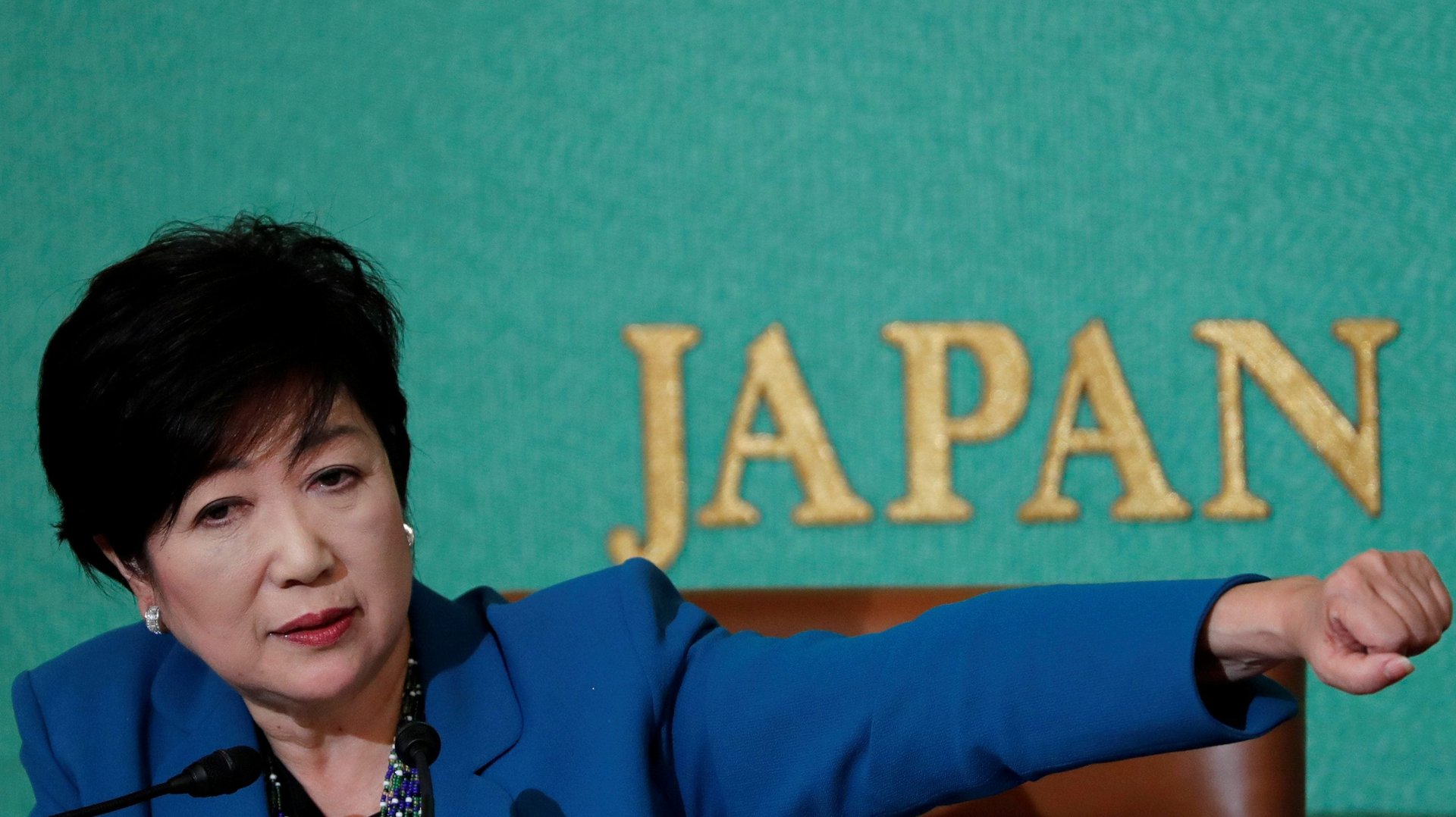Finally, Japan’s push for female empowerment is being lead by a woman
Tokyo’s proud and stubborn patriarchy hasn’t been the same since July 31, 2016. That’s when the capital city’s 14 million people opted to elect a woman for governor, over Prime Minister Shinzo Abe’s chosen candidate.


Tokyo’s proud and stubborn patriarchy hasn’t been the same since July 31, 2016. That’s when the capital city’s 14 million people opted to elect a woman for governor, over Prime Minister Shinzo Abe’s chosen candidate.
The establishment didn’t see Yuriko Koike coming. After a brief stint as defense minister in 2007, she spent several quiet years as a parliament member. But by mid-2016, Koike had enough of the revolving door of 60-something men from Japan Inc. central casting running Tokyo. All promised to diversify decision-making, narrow the gender gap, and pull more women into politics. All had failed. So, Koike threw her hat in the ring.
The timing was as ideal as Koike’s sales pitch: an outsider ready to upend the status quo in a city grown complacent. She zeroed in on corruption and tepid wage growth. Remarkably, she won male voters along with women, securing broad support from voters seeking fresh ideas and new energy. Her milestone put a spotlight on Japan’s gender-imbalance problem—and highlighted a clear solution to the economy’s decades-long malaise.
In just 14 months, Koike took on the powerful nuclear and tobacco lobbies. She demanded a detailed accounting of why 2020 Olympics costs are already double initial estimates. She delayed the relocation of the famed Tsukiji fish market because of toxic-soil concerns. Her popularity surged, while Abe’s waned amid cronyism scandals.
Now, Koike, 65, wants to take her success national with her brand-new Party of Hope, formed Sept. 25. It promises to boost stagnant wages, increase use of renewable energy, and raise Japan’s global competitiveness if given the mandate to do so in the national election taking place Sunday (Oct. 22).
It’s a decidedly uphill climb. Abe’s Liberal Democratic Party has essentially led Japan for 62 years, has a near-lock on rural voters, and uses its financial war chest to wage negative campaigns against challengers. But no matter the outcome Sunday, Japan’s liveliest election in ages is already producing a clear winner: women.
Since December 2012, Abe talked early and often about empowering women as part of his ‘Abenomics’ program. The scheme has three parts: monetary easing, fiscal loosening, and deregulation. Better utilizing the female workforce is a key element of phase three. Goldman Sachs estimates (pdf), for example, that gross domestic product would get a 15% boost if the female labor participation rate matched that of men (about 80%). Closing the gap is the fastest way to boost productivity and offset a shrinking and aging labor pool.
To date, Abe’s goal of making Japan a place where “all women can shine” is more hype than reality. Abe discarded a vow to ensure women hold 30% of leadership positions by 2020. On his watch, Japan fell on the World Economic Forum’s gender equality index, to 111th from 98th place. Japan, it bears noting, trails Saudi Arabia in the number of women in politics.
Koike’s party would do better. It plans to remove “institutional impediments” to gender-pay equality and a better work-life balance, and support more progressive corporate mindsets. Koike vows to prod more women to run for public office and speaks approvingly of Europe-like quotas for women in politics and business. Just 49 of the Party of Hope’s 234 candidates are women, highlighting how far Japan needs to go to recruit female candidates to run for office.
Yet the real power of the Koike effect may be filling the role-model void.
Abe, for example, only allotted two of 20 cabinet slots for women. He’s never entrusted a key ministry to a woman: foreign affairs, finance or chief cabinet secretary. The private sector is hardly diversity central: not one Nikkei 225 company is run by a Japanese woman.
Enter Koike, who’s leaning in to an extent Japan has never seen before— a smart, strong woman fluent in English, Arabic, and the language of political warfare.
“’Womeonomics’ needs a boost from its own kind,” says Nancy Snow, professor of foreign studies at Kyoto University. “Koike is able to speak from experience and not from the perspective of the current PM, who lacks authenticity on the issue. It’s like who do you want talking about women and economics—Donald Trump or Hillary Clinton?”
Koike “can serve as a model inspiring other women sick of being mommy-tracked and has tapped a woman as her deputy governor, backing up words with action,” adds Jeff Kingston, director of Asian studies at Temple University’s Tokyo campus. “Maybe this will goad Abe into delivering on some of his broken promises.”
Sheryl Sandberg’s 2013 bestseller Lean In urged women to challenge patriarchal norms. In Japan, though, equal pressure must come from the other side. Women entering the workforce face chronic job insecurity, maternity harassment, enabling human-resources departments and a near-impossible task of finding affordable daycare. Japan Inc. is still wedded to an early-20th century ethos of men work, women keep house—to its detriment.
Koike is challenging these growth-killing conventions— and Japanese gender stereotypes that women aren’t good leaders. On her 2013 book tour, Sandberg advised a Tokyo audience to “get rid of the idea that men lead organizations and it is appropriate for women to support the men’s jobs.” Koike is a bona fide conservative, part of a rightist movement seeking to alter the pacifist postwar constitution so that Japan can build a more muscular military. That could be a plus with skeptical male voters. Koike, Snow says, “speaks to policies that transcend her women status—nuclear, constitution—and she isn’t seen as ‘expecting’ the female support. Plus, so far, no big gaffes or controversies. Fingers crossed.”
Male-dominated Japan may never be the same—and that’s good news for its deflationary economy.